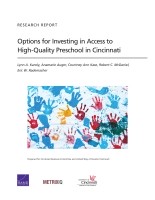| 来源类型 | Research Reports
|
| 规范类型 | 报告
|
| DOI | https://doi.org/10.7249/RR1615
|
| 来源ID | RR-1615-CBC/UWGC
|
| Options for Investing in Access to High-Quality Preschool in Cincinnati |
| Lynn A. Karoly; Anamarie A. Whitaker; Courtney Ann Kase; Robert C. McDaniel; Eric W. Rademacher
|
| 发表日期 | 2016
|
| 出版年 | 2016
|
| 页码 | 153
|
| 语种 | 英语
|
| 结论 |
There Is Room to Improve Preschool Access and Quality in Cincinnati- The supply of school- and center-based slots for preschool-age children can likely meet demand, but more needs to be done to increase quality.
- Two in three preschool-age children in Cincinnati qualify for state or federal preschool subsidies.
- Public subsidies tied to quality are insufficient to reach all income-eligible children with high-quality preschool programs.
- Stakeholders agreed with the need to expand access and improve quality.
Preschool Models from Nine U.S. Cities Demonstrate Varied Approaches but Share a Focus on High-Quality Programs- Most of the city preschool initiatives reviewed serve four-year-olds, typically on a universal basis, but expanded subsidies may be rolled out over time starting with low-income children.
- All nine cities have adopted mixed-delivery models, with both public and private providers delivering programs.
- Most cities subsidize school-day, school-year preschool programs; other features to achieve high quality are established either through standards or by requiring a high rating on the state quality rating and improvement system.
- Each city-funded preschool program has a locally controlled funding stream to cover its costs, in addition to leveraging existing federal and state subsidies.
- Infrastructure elements include governance, data systems, quality improvement supports and resources for workforce professional development, investment funds for facilities, and transportation services.
Financial and Economic Modeling Shows Range of Costs and Returns with Alternative Strategies for Expanding Access to High-Quality Preschool- Financial modeling highlights the range of investments that can be made, but the quality gap is a constraint in the near term.
- A positive economic return would be expected from investing in expanded preschool access and quality under both targeted and universal approaches.
|
| 摘要 |
- Focus on investing in the quality of Cincinnati preschool programs.
- Align expansion of funding for preschool to the availability of high-quality seats.
- Address challenges of blending and braiding funding streams.
- Align preschool programs with kindergarten to third grade.
- Monitor and evaluate current and new preschool investments.
|
| 主题 | Cincinnati
; Education Policy
; Preschool
; Preschool Children
; School Readiness
|
| URL | https://www.rand.org/pubs/research_reports/RR1615.html
|
| 来源智库 | RAND Corporation (United States)
|
| 引用统计 |
|
| 资源类型 | 智库出版物
|
| 条目标识符 | http://119.78.100.153/handle/2XGU8XDN/108362
|
推荐引用方式
GB/T 7714 |
Lynn A. Karoly,Anamarie A. Whitaker,Courtney Ann Kase,et al. Options for Investing in Access to High-Quality Preschool in Cincinnati. 2016.
|
|
文件名:
|
x1495316349689.jpg
|
|
格式:
|
JPEG
|

|
文件名:
|
RAND_RR1615.pdf
|
|
格式:
|
Adobe PDF
|
除非特别说明,本系统中所有内容都受版权保护,并保留所有权利。